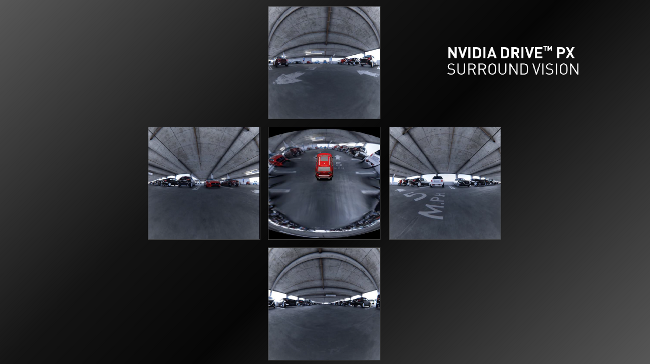NVIDIA CEO Jen-Hsun Huang unveiled the new 256-core chip, which uses the same Maxwell architecture deployed in the world’s top gaming graphics cards. Slated to arrive in products during the first half of the year, Tegra X1 provides more power than a supercomputer the size of a suburban family home from 15 years ago.
CEO Jen-Hsun Huang showed what Tegra X1 can do by revealing NVIDIA DRIVE computers for the car.
“Your future cars will be the most advanced computers in the world,” Jen-Hsun told a crowd of more than 350 reporters, analysts and partners packed into a ballroom at The Strip’s Four Season’s Hotel. “There will be more computing horsepower inside a car than anything you own today.”
NVIDIA DRIVE PX is a radical step toward the era of auto-piloted cars. Powered by dual Tegra X1 processors, DRIVE PX, with inputs for 12 high-resolution camera, promises to make driving safer and more enjoyable by introducing Surround-Vision and Auto-Valet capabilities.
NVIDIA DRIVE CX is a cockpit computer that can drive next-gen infotainment systems by lighting up to nearly 17 million pixels, better than 10-times the number in current state-of-the-art cars.
Eyes on the road: NVIDIA DRIVE PX weaves together different views to give next-generation cars better awareness of their surroundings
Jen-Hsun offered a stunning demonstration of DRIVE PX by using his smartphone to set a virtual car loose in a photorealistic digital garage.
The car wove its way through the garage, using computer vision to find an open space. Jen-Hsun could then call it back with the touch of a button.
“When you’re done with diner you say can come back to me… and it becomes ann auto-valet,” Jen-Hsun says. “That car meanders back out and gets back to the driver.“
Jen-Hsun also showed how the NVIDIA DRIVE CX cockpit computer can run stunning next-generation digital instrument clusters and infotainment systems inside the car.
Using NVIDIA DRIVE Studio software, designers can create digital cockpits that integrate features such as navigation and infotainment with next-generation driver aids such as Surround Vision, which gives drivers a top-down 360-degree view of the car in real time. Jen-Hsun showed how DRIVE Studio lets designers sculpt razor-sharp 3D digital cockpits that mimic the look and feel of real materials, from aluminum to carbon fiber and even bamboo.
Available with either Tegra X1 or Tegra K1 processors, and complete road-tested software, the DRIVE CX can power up to 16.8 million pixels on multiple displays – more than 10 times that of current model cars.
Supercomputer You Can Slide Into Your Pocket and for your car
The result is supercomputer-class performance. Tegra X1 packs more power than the fastest supercomputer of 15 years ago, ASCI Red.
Run for 10 years by the U.S. Department of Energy’s Sandia National Laboratory, ASCI Red was the first teraflops supercomputer system.
ASCI Red occupied 1,600 square feet and gulped 500,000 watts of power. By contrast Tegra X1 sips less than 15 watts of power.
NVIDIA DRIVE PX – our new auto-pilot car computer – opens the door to new era for the automotive industry. Powered by two Tegra X1 processors – and a host of advanced algorithms created by NVIDIA’s computer vision engineering team – DRIVE PX gives cars the brains to take over one of driving’s biggest headaches.
To show what DRIVE PX can do, engineers from our computer vision engineering and demo teams created a highly realistic virtual parking garage – using the blueprints from the actual garage at NVIDIA’s headquarters in Santa Clara — and relying on Epic Games’ Unreal Engine 4.
“It’s an incredibly rich and visually complex environment that simulates the way light reflects from cars and obstacles in real time,” says Mark Daly, who leads our demo team. ““It’s a perfect virtual world.”
DRIVE PX soaks up the information from this complex virtual world – simulated on on five PCs with NVIDIA GPUs – via virtual fisheye-lens cameras attached to a simulated car.
NVIDIA PX then uses sophisticated point cloud algorithms to turn those images into a real-time obstacle map as it moves through the garage, controlling the car’s throttle, brake and steering to move safely through the world around it.
The result: NVIDIA PX can search for an open spot in the crowded garage and slip into it with an expert series of turns. Press another button, and NVIDIA PX guides the car out of the space and back to the driver. No scratches or dinged fenders – not even virtual ones.
It’s proof that the once far-out idea of self-driving cars is closer than skeptics may think.
SOURCES – Nvidia

Brian Wang is a Futurist Thought Leader and a popular Science blogger with 1 million readers per month. His blog Nextbigfuture.com is ranked #1 Science News Blog. It covers many disruptive technology and trends including Space, Robotics, Artificial Intelligence, Medicine, Anti-aging Biotechnology, and Nanotechnology.
Known for identifying cutting edge technologies, he is currently a Co-Founder of a startup and fundraiser for high potential early-stage companies. He is the Head of Research for Allocations for deep technology investments and an Angel Investor at Space Angels.
A frequent speaker at corporations, he has been a TEDx speaker, a Singularity University speaker and guest at numerous interviews for radio and podcasts. He is open to public speaking and advising engagements.



